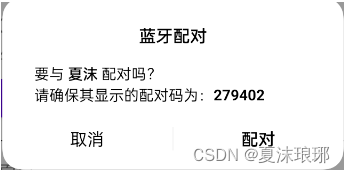Android BluetoothAdapter 使用(二)
2023-12-13 05:19:35
Android BluetoothAdapter 使用(二)
本篇文章主要讲下蓝牙设备的配对.
1: 蓝牙设备列表展示
下 面是蓝牙设备adapter的代码:
package com.test.bluetooth;
import android.bluetooth.BluetoothDevice;
import android.content.Context;
import android.view.LayoutInflater;
import android.view.View;
import android.view.ViewGroup;
import android.widget.BaseAdapter;
import android.widget.TextView;
import java.util.List;
/**
* @Author: zh
* @Time: 23-12-12.
* @Email:
* @Describe:
*/
public class DeviceAdapter extends BaseAdapter {
private Context context;
private List<BluetoothDevice> list;
public DeviceAdapter(Context context, List<BluetoothDevice> list) {
this.context = context;
this.list = list;
}
@Override
public int getCount() {
return list.size();
}
@Override
public Object getItem(int position) {
return list.get(position);
}
@Override
public long getItemId(int position) {
return position;
}
@Override
public View getView(int position, View convertView, ViewGroup parent) {
if (convertView == null) {
convertView = LayoutInflater.from(context).inflate(R.layout.item_device, parent, false);
}
BluetoothDevice bluetoothDevice = list.get(position);
TextView name = convertView.findViewById(R.id.item_name);
TextView address = convertView.findViewById(R.id.item_address);
name.setText(bluetoothDevice.getName());
address.setText(bluetoothDevice.getAddress());
View viewById = convertView.findViewById(R.id.item_btn);
viewById.setOnClickListener(v -> {
if (deviceConnect != null)
deviceConnect.doAction(bluetoothDevice);
});
return convertView;
}
DeviceConnect deviceConnect;
public void setDeviceConnect(DeviceConnect deviceConnect) {
this.deviceConnect = deviceConnect;
}
public interface DeviceConnect {
void doAction(BluetoothDevice bluetoothDevice);
}
}
item布局如下:
<?xml version="1.0" encoding="utf-8"?>
<LinearLayout
xmlns:android="http://schemas.android.com/apk/res/android"
android:layout_width="match_parent"
android:layout_height="wrap_content"
android:orientation="vertical"
>
<TextView
android:layout_width="wrap_content"
android:layout_height="wrap_content"
android:layout_marginLeft="15dp"
android:layout_marginTop="15dp"
android:id="@+id/item_name"
android:text="xxxxx"
android:textSize="20sp"
/>
<TextView
android:layout_width="wrap_content"
android:layout_height="wrap_content"
android:id="@+id/item_address"
android:layout_marginTop="5dp"
android:layout_marginLeft="15dp"
android:textSize="16sp"
/>
<Button
android:layout_width="wrap_content"
android:layout_height="wrap_content"
android:textSize="16sp"
android:text="配对"
android:layout_marginTop="5dp"
android:layout_marginLeft="15dp"
android:id="@+id/item_btn"
/>
<View
android:layout_width="match_parent"
android:layout_height="1dp"
android:layout_marginTop="15dp"
android:background="#333"
/>
</LinearLayout>
另外由于嵌套使用listview. 这里简单自定义了listview,重新计算了高度.
package com.test.bluetooth;
import android.content.Context;
import android.util.AttributeSet;
import android.widget.ListView;
public class MyListView extends ListView {
public MyListView(Context context, AttributeSet attrs) {
super(context, attrs);
}
@Override
public void onMeasure(int widthMeasureSpec, int heightMeasureSpec) {
int mExpandSpec = MeasureSpec.makeMeasureSpec(Integer.MAX_VALUE >> 2, MeasureSpec.AT_MOST);
super.onMeasure(widthMeasureSpec, mExpandSpec);
}
}
扫描蓝牙设备列表的代码,可以看下我的上篇文章,这里简单写下:
private final BroadcastReceiver receiver = new BroadcastReceiver() {
public void onReceive(Context context, Intent intent) {
String action = intent.getAction();
if (BluetoothDevice.ACTION_FOUND.equals(action)) {
// Discovery has found a device. Get the BluetoothDevice
// object and its info from the Intent.
BluetoothDevice device = intent.getParcelableExtra(BluetoothDevice.EXTRA_DEVICE);
String deviceName = device.getName();
String deviceHardwareAddress = device.getAddress(); // MAC address
if (!TextUtils.isEmpty(deviceName)){
listFind.add(device);
findAdapter.notifyDataSetChanged();
}
Log.d(TAG, "onReceive: deviceName:" + deviceName + "; deviceHardwareAddress:" + deviceHardwareAddress);
}
}
};
findAdapter.setDeviceConnect(new DeviceAdapter.DeviceConnect() {
@Override
public void doAction(BluetoothDevice bluetoothDevice) {
bindDevice(bluetoothDevice.getAddress());
}
});
配对设备的代码如下:
private void bindDevice(String address) {
BluetoothDevice remoteDevice = bluetoothAdapter.getRemoteDevice(address);
if (Build.VERSION.SDK_INT >= Build.VERSION_CODES.KITKAT) {
remoteDevice.createBond();
}
}
点击效果如下:

文章来源:https://blog.csdn.net/qq_23025319/article/details/134958985
本文来自互联网用户投稿,该文观点仅代表作者本人,不代表本站立场。本站仅提供信息存储空间服务,不拥有所有权,不承担相关法律责任。 如若内容造成侵权/违法违规/事实不符,请联系我的编程经验分享网邮箱:veading@qq.com进行投诉反馈,一经查实,立即删除!
本文来自互联网用户投稿,该文观点仅代表作者本人,不代表本站立场。本站仅提供信息存储空间服务,不拥有所有权,不承担相关法律责任。 如若内容造成侵权/违法违规/事实不符,请联系我的编程经验分享网邮箱:veading@qq.com进行投诉反馈,一经查实,立即删除!